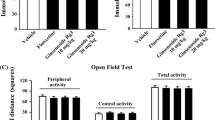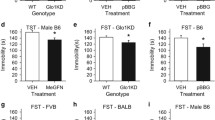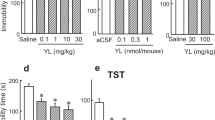Abstract
Background
Nemifitide is a novel peptide analog of melanocyte-inhibiting factor (MIF) that has been reported to relieve depressive symptoms in a very short period.
Objectives
The Flinders Sensitive Line (FSL) rat, a genetic animal model of depression with innate exaggerated immobility in the forced swim test, was used to obtain more detailed information about the antidepressant-like effects of nemifitide.
Methods
The FSL rats were treated chronically with various doses of nemifitide or reference antidepressants desipramine and fluoxetine for 5 or 14 days and the forced swim test was conducted 22–24 h after the last treatment.
Results
Nemifitide significantly increased swimming in the FSL rats at both low (0.025–0.3 mg/kg) and high (3.0–15.0 mg/kg) doses but not at intermediate (0.4–2.4 mg/kg) doses. Nemifitide (0.3 mg/kg) and desipramine (5.0 mg/kg) significantly increased swimming in the FSL rats after just 5 days of treatment, but fluoxetine (5.0 mg/kg) did not. Nemifitide (0.3 mg/kg) and fluoxetine (5.0 mg/kg) had long-lasting effects, but desipramine (5.0 mg/kg) did not.
Conclusions
These findings support the value of developing nemifitide and its analogs as potential antidepressants.




Similar content being viewed by others
References
Artigas F, Romero L, de Montigny C, Blier P (1996) Acceleration of the effect of selected antidepressant drugs in major depression by 5-HT1A antagonists. Trends Neurol Sci 19:378–383
Blier P (2003) The pharmacology of putative early onset antidepressant strategies. Eur Neuropsychopharmacol 13:57–66
Borsini F, Cesana R (2001) Mechanism of action of flibanserin in the learned helpless paradigm in rats. Eur J Pharmacol 433:81–89
Borsini F, Meli A (1988) Is the forced swim test a suitable model for revealing antidepressant activity? Psychopharmacology 94:147–160
Bushnell PJ, Levin ED, Overstreet DH (1995) Spatial working and reference memory in rats bred for autonomic sensitivity to cholinergic stimulation; acquisition, accuracy, speed, and effects of cholinergic drugs. Neurobiol Learn Mem 63:116–132
Cervo L, Grignaschi, Rossi C, Samanin S (1991) Role of serotonergic neurons in the effects of sertraline in rats in the forced swimming test. Eur J Pharmacol 196:217–222
Ehrensing RH, Kastin AJ, Wurzlow GF, Michell GF, Mebane AH (1994) Improvement in major depression after low subcutaneous doses of MIF-1. J Affect Disord 31:227–233
Feighner JP (2003) Clinical and preclinical overview of nemifitide (INN 00835), a novel pentapeptide antidepressant. Presentation at the Pasteur Institute Congress, Paris
Feighner JP, Ehrensing RH, Kastin AJ, Leonard BE, Sverdlov L, Nicolau G, Patel A, Hlavka JJ, Abajian H, Noble JF (2000a) A double-blind, placebo-controlled, efficacy, safety, and pharmacokinetic study of INN 00835, a novel antidepressant peptide, in treatment of major depression. J Affect Disord 61:119–126
Feighner JP, Sverdlov L, Nicolau G, Noble JF (2000b) Cluster analysis of clinical data to identify subtypes within a study population following treatment with a new pentapeptide antidepressant. Int J Neuropsychopharmacol 3:237–242
Feighner JP, Ehrensing RH, Kastin AJ, Patel A, Sverdlov L, Hlavka J, Abajian HB, Noble JF, Nicolau G (2001) Double-blind, placebo-controlled study of INN 00835 (nemifitide) in the treatment of outpatients with major depression. Int Clin Psychopharmacol 16:345–352
Feighner JP, Nicolau G, Abajian H, Marricco NC, Morrison J, Sverdlov L, Hlavka J, Tonelli G Jr, DiSpirito C, Faria G (2002) Clinical pharmacokinetic studies with INN 00835 (nemifitide), a novel pentapeptide antidepressant. Biopharmaceut Drug Dispos 23:33–39
Hiemke C, Hartter S (2000) Pharmacokinetics of selective serotonin reuptake inhibitors. Pharmacol Ther 85:11–28
Hlavka JJ, Abajian HB, Noble JF (1996) Chemistry and pharmacology of novel antidepressant peptide. Pharm Res 13:143
Hlavka JJ, Feighner JP, Abajian H, Nicolau G, Morrison J, Sverdlov L (2002) Chemistry, pharmacology and clinical studies of nemifitide, a novel antidepressant peptide. Drugs Fut (Suppl A):273
Janowsky DS, Overstreet DH, Nurnberger JI Jr (1994) Is cholinergic sensitivity a genetic marker for the affective disorders? Am J Med Genet (Neuropsychiatr Genet) 54:335–344
Kastin AJ, Scollan EL, Ehrensing RH (1978) Enkephalin and other peptides reduce passiveness. Pharmacol Biochem Behav 9L:515–519
Kastin AJ, Honour LC, Coy DH (1981) Effects of MIF-1 and three related peptides on reserpine-induced hypothermia in mice. Pharmacol Biochem Behav 15:983–985
Kelly JP, Leonard BE (1994) The effects of tianeptine and sertraline in three animal models of depression. Neuropharmacology 33:1011–1016
Kelly JP, Wrynn AS, Leonard BE (1997) The olfactory bulbectomized rat as a model of depression: an update. Pharmacol Ther 74:299–316
Kelly J, Harkin A, Nicolau G, Feighner JP, Leonard BE (2002) A preclinical investigation of the mechanism of action of Nemifitide: a possible role for serotonin? Int J Neuropsychopharmacol 5(Suppl 1):S97
Nicolau G, Feighner JP, Reimer M, Li A, Hu Z, Hlavka J (2002) Metabolism of the antidepressant nemifitide and its potential for drug interactions. Int J Neuropsychopharmacol 5 (Suppl 1):S204
Nicolau G, Feighner JP, Silber P, Chen G, Abajian H, Bathala M (2003) Metabolism phenotype and in vitro drug–drug interaction studies with Nemifitide, a novel pentapeptide antidepressant. Eur Neuropsychopharmacol 13 (Suppl 4):S194
Overstreet DH (1986) Selective breeding for increased cholinergic function: development of a new animal model of depression. Biol Psychiatry 2l:49–58
Overstreet DH (1993) The Flinders Sensitive Line rats: a genetic animal model of depression. Neurosci Biobehav Rev 17:51–68
Overstreet DH (2002) Behavioral characteristics of rat lines selected for differential hypothermic responses to cholinergic or serotonergic agonists. Behav Genet 32:335–348
Overstreet DH, Russell RW (1982) Selective breeding for sensitivity to DFP. Effects of cholinergic agonists and antagonists. Psychopharmacology 78:150–154
Overstreet DH, Dilsaver SC, Janowsky DS, Rezvani AH (1990) Effects of bright light on responsiveness to a muscarinic agonist in rats selectively bred for endogenously increased cholinergic function. Psychiatry Res 33:149–150
Overstreet DH, Rezvani AH, Pucilowski O, Gause L, Janowsky DS (1994) Rapid selection for serotonin-1A sensitivity in rats. Psychiatr Genet 4:57–62
Overstreet DH, Pucilowski O, Rezvani AH, Janowsky DS (1995) Administration of antidepressants, diazepam and psychomotor stimulants further confirms the utility of Flinders Sensitive Line rats as an animal model of depression. Psychopharmacology 121:27–37
Overstreet DH, Rezvani AH, Knapp DJ, Crews FT, Janowsky DS (1996) Further selection of rat lines differing in 5-HT-1A receptor sensitivity: behavioral and functional correlates. Psychiatr Genet 6:107–117
Overstreet DH, Pucilowski O, Rettori M-C, Delagrange P, Guardiola-Lemaitre B (1998) Anti-immobility effects of a melatonin receptor agonist, but not antagonist, in a genetic animal model of depression. NeuroReport 9:249–253
Pignatiello MF, Olson GA, Kastin AJ, Ehrensing RH, McLean JH, Olson RD (1989) MIF-1 is active in a chronic stress animal model of depression. Pharmacol Biochem Behav 32:737–742
Plenge P, Mellerup ET (2003) Pindolol and the acceleration of the antidepressant response. J Affect Disord 75:285–289
Porsolt RD, Anton G, Blavet N, Jalfre M (1977) Behavioral despair in rats: a new model sensitive to antidepressant treatment. Eur J Pharmacol 47:379–391
Pucilowski O, Overstreet DH (1993) Effect of chronic antidepressant treatment on responses to apomorphine in selectively bred rat strains. Pharmacol Biochem Behav 32:471–475
Pucilowski O, Overstreet DH, Rezvani AH, Janowsky DS (1993) Chronic mild stress-induced anhedonia: greater effect in genetic rat model of depression. Physiol Behav 54:1215–1220
Raghavendra V, Kaur G, Kulkarni SK (2000) Antidepressant action of melatonin in chronic forced swim-induced behavioral despair in mice, role of peripheral benzodiazepine receptor modulation. Eur Neuropsychopharmacol 10:473–481
Sanchez C, Hyttel J (1999) Comparison of the effects of antidepressants and their metabolites on reuptake of biogenic amines and on receptor binding. Cell Mol Neurobiol 19:467–489
Schiller GD, Pucilowsky O, Overstreet DH (1992) Immobility-reducing effect of antidepressants in a genetic animal model of depression. Brain Res Bull 28:821–823
Shiromani PJ, Overstreet DH, Levy D, Goodrich CA, Campbell SS, Gillin JC (1988) Increased REM sleep in rats selectively bred for cholinergic hyperactivity. Neuropsychopharmacology 1:127–133
Shiromani PJ, Overstreet DH, Lucero S (1990) Failure of dietary lithium to alter immobility in animal model of depression. Lithium 1:241–244
van der Velde CD (1983) Rapid clinical effectiveness of MIF-1 in the treatment of major depressive illness. Peptides 4:297–300
Willner P (1997) Validity, reliability and utility of the chronic mild stress model of depression: a 10-year review and evaluation. Psychopharmacology 134:129–139
Willner P, Muscat R, Papp M (1993) Chronic mild stress-induced anhedonia: a realistic animal model of depression. Neurosci Biobehav Rev 16:525–534
Yadid G, Zangen A, Dmitrochenko A, Overstreet DH, Zohar J (2000) Screening for new antidepressants with fast onset and long-lasting action. Drug Dev Res 50:392–399
Acknowledgments
Support for this work was provided by Innapharma, Inc. via a standard contract with the University of North Carolina at Chapel Hill. Dr Overstreet was not independently compensated by Innapharma, Inc. nor does he has a financial interest in the company. The technical assistance of Qi Yu and Mili Senapati is acknowledged. This work was funded by Innapharma, Inc.
Author information
Authors and Affiliations
Corresponding author
Rights and permissions
About this article
Cite this article
Overstreet, D.H., Hlavka, J., Feighner, J.P. et al. Antidepressant-like effects of a novel pentapeptide, nemifitide, in an animal model of depression. Psychopharmacology 175, 303–309 (2004). https://doi.org/10.1007/s00213-004-1815-9
Received:
Accepted:
Published:
Issue Date:
DOI: https://doi.org/10.1007/s00213-004-1815-9




